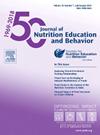Diet Quality Among Community Members With Diabetes and Food Insecurity in Northwest Arkansas: Comparison Across 3 Racial/Ethnic Groups
IF 2.3
3区 医学
Q2 EDUCATION, SCIENTIFIC DISCIPLINES
引用次数: 0
Abstract
Objective
This study evaluated differences in diet quality across multiple racial/ethnic groups with type 2 diabetes (T2D) experiencing food insecurity.
Design
Cross-sectional. Bilingual (English/Spanish, English/Marshallese) community health workers used a multiple-pass approach to collect 3 24-hour dietary recalls via phone.
Setting
Food pantries in Arkansas.
Participants
Eighty-three adult food pantry clients with T2D (hemoglobin A1c ≥ 7.0%) experiencing food insecurity and self-identified race/ethnicity of Hispanic (39%), Marshallese Pacific Islander (i.e., Marshallese) (35%), or White (26%).
Main Outcome Measure
Diet quality (Healthy Eating Index [HEI]-2015).
Analysis
Differences in diet quality scores by race/ethnicity were evaluated using one-way analysis of variance; Turkey-Kramer tests for pairwise comparisons assessed diet quality differences among Hispanic, Marshallese, and White participants. A food-level analysis identified top food categories contributing to diet quality.
Results
Diet quality was 71.7 ± 12.7 (mean ± standard deviation) among Hispanic, 56.9 ± 14.1 among Marshallese, and 45.9 ± 14.1 among White participants. Hispanic participants had a significantly higher HEI-2015 score than Marshallese (mean difference, 14.9 [95% confidence interval (CI), 6.6–23.2]; P < 0.001) and White (mean difference, 25.9 [95% CI, 16.9–34.8]; P < 0.001) participants. Marshallese participants had a significantly higher HEI-2015 score than White participants (mean difference, 11.0 [95% CI, 1.8–20.1]; P = 0.01).
Conclusions and Implications
Designers of nutrition-focused interventions may consider tailoring food and education around high and low diet quality component scores that vary across racial/ethnic groups (e.g., including culturally appropriate fruits/vegetables) to improve T2D management.
阿肯色州西北部糖尿病和食品不安全社区成员的饮食质量:3个种族/族裔群体的比较
目的:本研究评估了食物不安全的多种族/民族2型糖尿病(T2D)患者饮食质量的差异。设计:横断面。双语(英语/西班牙语、英语/马绍尔语)社区卫生工作者采用多通道方法,通过电话收集了3次24小时饮食召回。背景:阿肯色州的食品储藏室。参与者:83名患有T2D(血红蛋白A1c≥7.0%)的成年食品储藏室客户,经历食品不安全,自我认定的种族/民族为西班牙裔(39%)、马绍尔太平洋岛民(即马绍尔人)(35%)或白人(26%)。主要结局指标:饮食质量(健康饮食指数[HEI]-2015)。分析:采用单因素方差分析评估不同种族/民族饮食质量评分的差异;两两比较的Turkey-Kramer测试评估了西班牙裔、马绍尔人和白人参与者的饮食质量差异。一项食物水平分析确定了影响饮食质量的主要食物类别。结果:西班牙裔受试者的饮食质量为71.7±12.7(平均±标准差),马沙尔裔受试者为56.9±14.1,白人受试者为45.9±14.1。西班牙裔受试者的HEI-2015评分显著高于马沙尔人(平均差异为14.9[95%可信区间(CI), 6.6-23.2];P < 0.001)和White(平均差异25.9 [95% CI, 16.9-34.8];P < 0.001)。马沙尔人的HEI-2015评分显著高于白人(平均差异为11.0 [95% CI, 1.8-20.1];P = 0.01)。结论和启示:以营养为重点的干预措施的设计者可以考虑根据不同种族/民族(例如,包括文化上合适的水果/蔬菜)的饮食质量成分得分高低来调整食物和教育,以改善T2D管理。
本文章由计算机程序翻译,如有差异,请以英文原文为准。
求助全文
约1分钟内获得全文
求助全文
来源期刊
CiteScore
4.20
自引率
11.50%
发文量
379
审稿时长
44 days
期刊介绍:
The Journal of Nutrition Education and Behavior (JNEB), the official journal of the Society for Nutrition Education and Behavior, is a refereed, scientific periodical that serves as a global resource for all professionals with an interest in nutrition education; nutrition and physical activity behavior theories and intervention outcomes; complementary and alternative medicine related to nutrition behaviors; food environment; food, nutrition, and physical activity communication strategies including technology; nutrition-related economics; food safety education; and scholarship of learning related to these areas.
The purpose of JNEB is to document and disseminate original research and emerging issues and practices relevant to these areas worldwide. The Journal of Nutrition Education and Behavior welcomes evidence-based manuscripts that provide new insights and useful findings related to nutrition education research, practice and policy. The content areas of JNEB reflect the diverse interests in nutrition and physical activity related to public health, nutritional sciences, education, behavioral economics, family and consumer sciences, and eHealth, including the interests of community-based nutrition-practitioners. As the Society''s official journal, JNEB also includes policy statements, issue perspectives, position papers, and member communications.

 求助内容:
求助内容: 应助结果提醒方式:
应助结果提醒方式:


